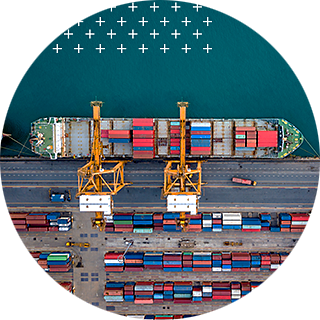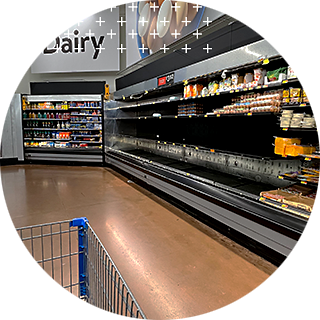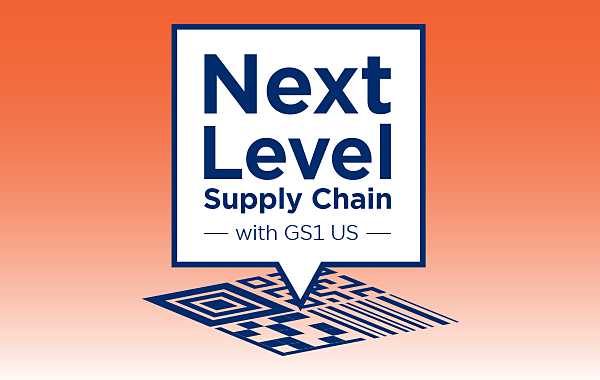Not implementing best practices can be costly – in both time and money. By tracking your products from start to finish and knowing their location and estimated arrival, you can better control your costs. This control helps manage expenses from delays, disruption, or other errors. Understanding your inventory by tracking deliveries and understanding demand helps minimize excess inventory and waste.
A supply chain is a coordinated network of partners, professionals, and businesses that move products and goods from their source or manufacturing location, all the way to the customer. They play a vital role in keeping global commerce, healthcare, and the food supply moving across various industries such as food, healthcare, and general merchandise.
Supply chain management is the key to keeping the world healthy, fed, and prosperous. With an eye toward efficiency, optimizing the process can assist businesses and consumers trace products, ensure safety, and avoid counterfeiting.
Maximizing the efficiency of a supply chain helps the world to embrace more sustainable practices, minimize waste, and most importantly make the health of the planet a priority.
The global pandemic showed us that resilient supply chains quickly adjust to changes in demand. The ability to make quick changes ensures that critical products reach their destinations to the people who need them the most.

The Supply Chain Process
The supply chain process is a complex network of relationships among trading partners who are responsible for moving products from one place to another. Having an effective process depends on seamlessly sharing information across the different phases of a product’s lifecycle. Recent events, like the COVID-19 pandemic, have made it clear that a linear supply chain process is fragile. Below are key process checkpoints and how they keep things moving:
1 | Planning, Sourcing, and Procurement of Raw Materials
This part of the process is about finding and paying for the right goods to support the business. This includes direct procurement, which involves obtaining goods, raw materials, or services for making a product, and indirect procurement for non-production supplies.
2 | Manufacturing
Manufacturing is the process of converting input materials into finished products. The process can happen across multiple phases, where each phase adds value and makes different uses of the output possible.
3 | Assembly
In the assembly stage, a product is taken to its finished state. This process may involve machinery, manual labor, and equipment to convert raw materials into the final product.
4 | Packaging and Warehousing
At this point, finished products are packed, weighed, labeled, and stored in warehouses until they are ready to be transported.
5 | Shipping, Logistics, and Transportation
This aspect is about planning and executing the management and movement of goods from point of origin to consumption. It includes the movement of goods to different customers, which can include manufacturers, distributors, or consumers.
6 | Retail, Distribution, and Wholesale
This part of the supply chain process is about getting products into the market. Distributors work with manufacturers to sell the goods to other parties along the supply chain, such as wholesalers. Wholesalers buy goods in bulk, often from distributors, and sell them to retailers – and then retailers sell those goods to consumers.
Supply Chain Improvement
As the speed of business accelerates and consumer trends evolve, processes are consistently required to improve to keep up. New technology and cutting-edge innovations are helping to capture data and streamline operations. Below are some high-level outcomes that help improve supply chains from the ground up:
Improve Visibility
Having greater visibility gives you the opportunity to track every product, at all touchpoints toward its final destination. By leveraging data, standards, and technology to get real-time information on the location and status of your products, you can pivot quickly as demand changes and minimize disruption in shipments, if and when it occurs.
Control Cost
Types of Supply Chains
There is no one-size-fits all when it comes to supply chains. But there is one school of thought that remains consistent: having an effective, resilient one is critical for business success. Trading partner relationships can be complex, and your supply chain can take different forms, depending on your business needs.
We will outline several approaches that may match your products, business values, and maybe even the preferences of your customers.
Circular supply chains are strongly associated with sustainable supply chains. Circular supply chains focus on maximizing the lifespan of products, assets, and infrastructure. They prioritize reusing, repurposing, and recycling materials to ensure they are transformed and used again.
The goal of this type of circular system is to achieve a more resilient supply chain. By converting waste streams into value streams, the system aims to mitigate the impact and cost of waste, while reducing reliance on finite virgin resources. Circular supply chains enable alternative, flexible strategies for sourcing to offset resource scarcity and volatility.
An agile supply chain is simply one that is flexible and able to pivot according to market demand or circumstances. This approach can be simplified as “quickly wait and see.” This process delays product completion to respond directly and actively to market demand, instead of relying on forecasting.
These supply chains are typically used for products that are easily customizable, with shorter life cycles, like fast fashion. Brands like these essentially want to make sure they have the agility to jump on trends quickly to address consumer demand.
Lean supply chains are common and resemble the traditional factory assembly line model, aiming to maximize product output while minimizing costs. Lean supply chains keep end-user, consumer cost in mind.
These types of supply chains are well-suited for essential or functional consumer goods, such as personal care products or toiletries. These products have stable demand and low market volatility, enabling advance planning and flexible production for higher volumes at minimal cost.
The pharmaceutical supply chain ensures safety along the movement of medications and other pharmaceutical products from sourcing all the way to patient delivery. The pharmaceutical supply chain requires increased collaboration and coordination. It involves multiple stakeholders, trading partners, and regulatory guidelines at each checkpoint to protect patient safety.
Due to the high stakes involved in supply chains like this, it is critical that best practices are put in place for manufacturing, inventory and demand management, traceability, as well as production planning and scheduling.
A cold supply chain is for goods that require strict temperature control as they move from manufacture to consumption. The products in a cold supply chain are often sensitive in nature, such as vaccines or biologics or perishable food items. To ensure the safety and effectiveness of the product, trading partners monitor the temperature conditions constantly. As a result, it is critical for all participants to adhere to best practices.
Additionally, effective information sharing among all parties is crucial to quickly address any changes that fall outside the requirements. If such an event were to go undetected, product quality as well as patient or consumer health could be at risk.

Supply Chain Disruptions and Risks
Effective supply chain management reduces the impact, alleviates stress, and manages the additional consequences of disruptions, making it a best practice to follow. However, preparing for the unexpected can only take you so far. The examples below are some things you can consider for greater supply chain efficiency and success:
Managing your inventory levels goes hand in hand with forecasting. By properly planning, forecasting, and effectively managing inventory levels, you can avoid overordering or underordering products and meet market demand consistently. Inaccurate estimates can result in higher costs, including excess inventory and delays, while also impacting trust with trading partners and customers.
Poor management of inventory can lead to overstock or "dead" inventory. This is inventory that is deemed unsellable and often causes a business to take a loss and liquidate unwanted products. Excess inventory often results in less available operating revenue.
Not only is it critical to reliably monitor your supply chain, it’s also important to build trusted relationships with suppliers. This means having a full understanding of how well a supplier meets their commitments to their partners and customers. It’s important to be aware of any issues related to their quality of products, cost, product information accuracy, and/or delivery time.
Ensuring you are working with reliable partners helps your overall supply chain work better and run smoother to effectively meet demand.
Lead or shipping times required for a product can be another risk to the efficiency of your supply chain. With multiple products moving to various locations at one time, it’s essential to optimize a product's transportation routes. This minimizes transportation costs, ensures on-time delivery, and allows a business to scale up as demand grows.
Supply chain compliance means that you, your suppliers, and manufacturers are meeting all applicable regulations. This also means that all involved parties abide by local and international laws and source products ethically. Without this, the cost can be massive and may result in fines or other negative impacts on your business.
It is critical to ensure that you and your trading partners are up to speed on the required regulations. These regulations can impact food, healthcare, and other products that help monitor consumer safety.

Start Your Journey or Optimize Your Existing Supply Chain with GS1 US
Running an effective and efficient supply chain is no easy task, but you never have to do it alone. GS1 US has worked with industries for over 50 years to develop globally accepted standards, valuable guidance, and best practices. GS1 US helps brands and companies, large and small, ensure they run visible, resilient, and successful supply chains.
GS1 Standards are the building blocks and common data language that help all parties along the supply chain. This way, all trading partners can work seamlessly together, exchanging data quickly and digitally.
GS1 US offers support in transforming your supply chain from a simple barcode system to an interconnected, data-rich network. GS1 US can help your business expand, adapt, and respond to evolving consumer demands. No matter your product – food, general goods, cash, or life-saving medical devices and medications – GS1 US can help. Collaborate with experts, learn standards guidance, and access educational resources to build confidence for continued supply chain resilience and success.




